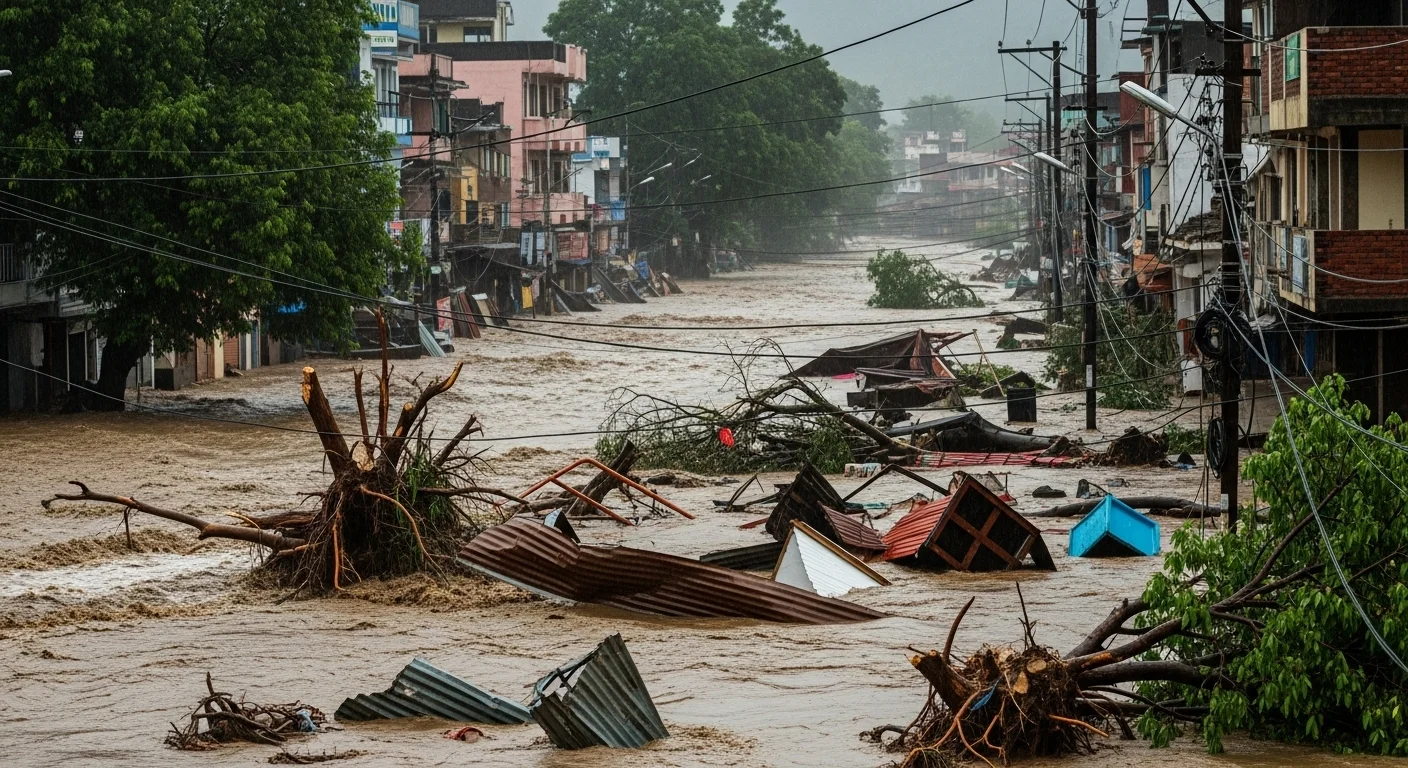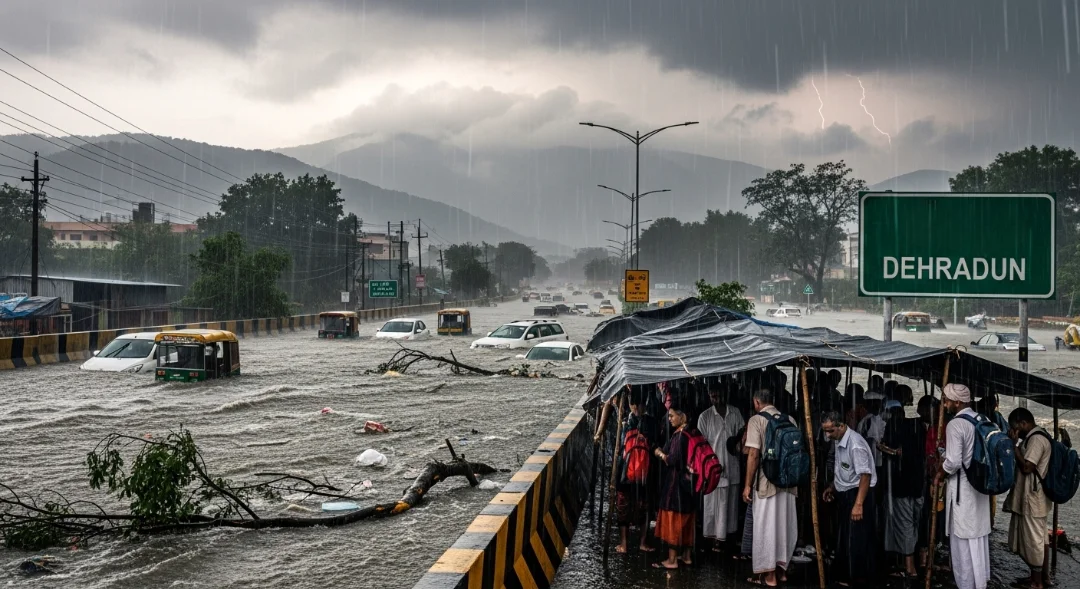Uttarakhand monsoon season has gone historic as Dehradun receives heaviest rainfall in 74 years, paralyzing life throughout the state. The heavy rainfall has resulted in largescale waterlogging, landslides, and traffic halts, prompting authorities to suspend a number of pilgrimage routes for the time being. With both locals and travelers stranded, the state is on high alert, and advisories have been issued for caution against unnecessary travel to affected regions.
This Year Dehradun Receives Heaviest Rainfall in 74 Years
Local weather reports indicate that Dehradun Receives heaviest rainfall in 74 years, exceeding all previous records and inundating some low-lying areas. Rainwater has flooded homes, shops, and government buildings, posing a task for rescue and relief efforts. The authorities have sent disaster management teams to help stranded people and ensure that emergency materials are delivered to affected residents.
Effects on Pilgrims and Tourism
Historic rains have extensively affected the Char Dham Yatra and other pilgrimage paths. The roads to popular shrines such as Yamunotri and Gangotri have been closed temporarily due to landslides and flooding. Pilgrims were asked to take shelter in safer places until the weather conditions ease. Tour agencies have also canceled journeys to vulnerable mountain routes, as Dehradun Receives heaviest rain in 74 years, increasing chances of further landslides and road obstructions.
Transportation and Connectivity Interruptions

Internal roads and major roads have been choked by Dehradun Receives heaviest rainfall in 74 years, waterlogging and debris. Trains to and from Dehradun have been delayed, and bus operations have been canceled or diverted. Flight operations at Jolly Grant Airport are running on a cautious schedule because of low visibility. Local transport within the city has also been hampered, as some major roads continue to be waterlogged.
Also Read: Red Alert for Uttarakhand & Himachal Pradesh: Essential Travel Advisory & Latest Updates
Safety Precautions and Guidelines
While Dehradun Receives heaviest rainfall in 74 years, the state government has released stern guidelines for citizens and tourists:
- Avoid making unnecessary trips to hill stations and riverbanks.
- Have emergency packages prepared, such as drinking water, food supplies, and medicines.
- Keep yourself informed through official weather reports.
- Be guided by local authorities in terms of evacuation and shelter.
Rescue and Relief Operations
The state government, in collaboration with the National Disaster Response Force (NDRF) and State Disaster Response Force (SDRF), initiated massive rescue and relief efforts. Helicopters and boats were used to evacuate residents who had been marooned in flooded areas.
The relief camps were established to give shelter, food, and medicine to people who were displaced due to the floods. In addition, engineers were sent to examine and repair damaged roads and bridges so that basic supplies would be able to reach flooded regions.
Also Read: Uttarakhand Weather Update: Traffic, Travel Plans Hit by Heavy Rain in Dehradun & Major Districts
Why This Rainfall is Significant
The fact that Dehradun witnessed heaviest rainfall in 74 years isn’t merely a weather record it’s a wake-up call for altering climate trends in the Himalayas. Such unprecedented weather events are attributed by experts to global warming, deforestation, and uncontrolled urbanization, which increase the risk of flooding and landslides in Uttarakhand.
Safety Tips for Travelers During Monsoon in Uttarakhand
While the beauty of the hills of Uttarakhand is unquestionable, visitors need to be careful during the monsoon season. Some important safety precautions are:
- Refer to weather forecasts prior to leaving and avoid journeying during red warnings.
- Pack rain gear like water-resistant jackets, umbrellas, and good footwear.
- Steer clear of riverbeds and landslide-sensitive slopes when there is excessive rainfall.
- Take local advice and road closing notices from the district administration.
- Have emergency contact numbers available and keep travel insurance up-to-date.
The Road to Recovery
As the rain let up, officials had the daunting task of getting things back to normal. Clearing the rubble, repairing roads, and opening pilgrimage corridors were given topmost priority. Environmentalists also emphasize planning sustainable infrastructure in hill states so that they can withstand future weather shocks.
The calamity has yet again drawn into question the preparedness of the state for adverse weather conditions. Experts opine that stronger early-warning systems, stricter building standards, and improved drainage facilities are needed to prevent extensive damage in the future Due to Dehradun received heaviest rainfall in 74 years and landslides
Conclusion
The fact that Dehradun received heaviest rainfall in 74 years has left an unforgettable impression on the history of the city and is a wake-up call for the authorities as well as the travelers. As rescue operations continue and the government attempts to bring about normalcy, safety is the priority for everyone in the area. The beauty of the monsoon in the Himalayas is sure to be breathtaking, but as this incident has revealed, it requires respect and care from everyone who witnesses it.







